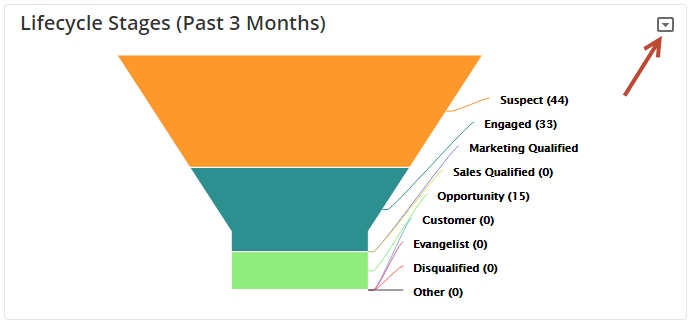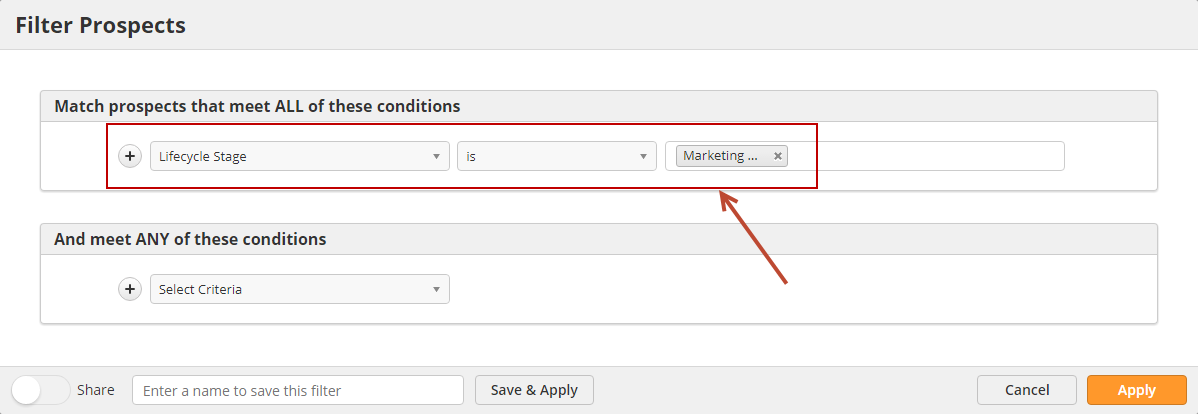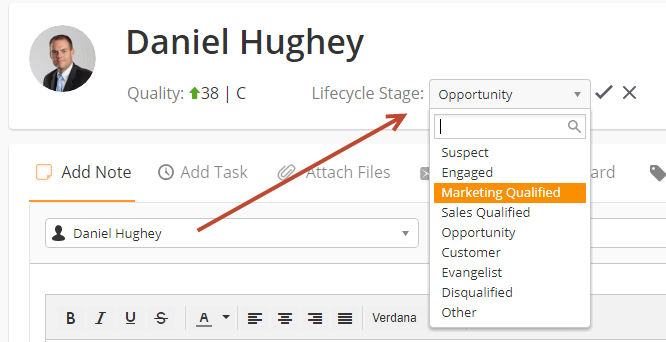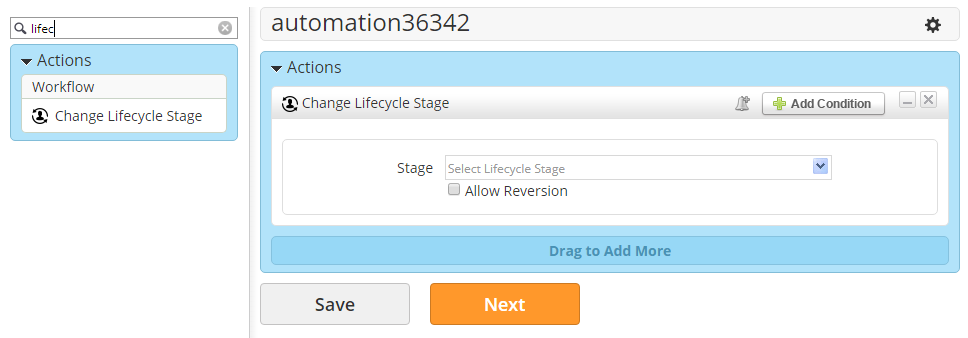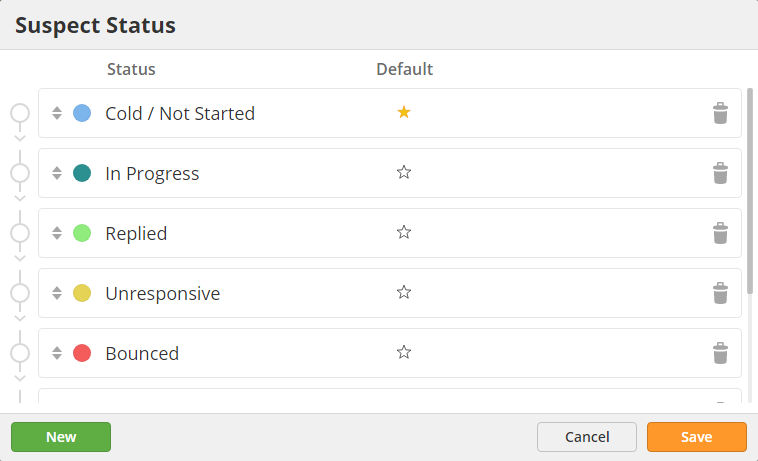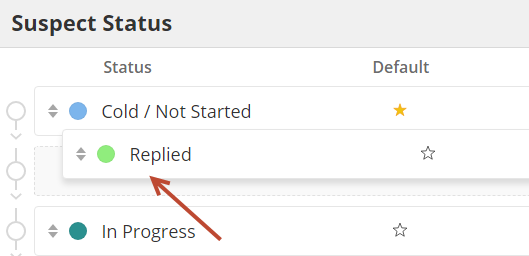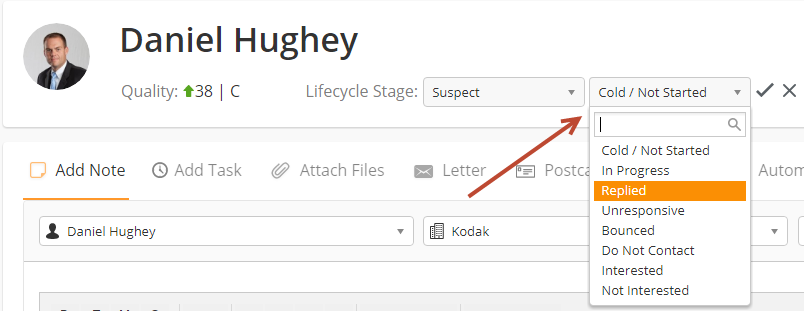Lifecycle Stages
Overview
Lifecycle Stages give you a full perspective on where a Prospect is in your sales and marketing processes. Prospects are meant to be promoted through each Lifecycle Stage, from beginning to end. The order of the Lifecycle Stages is as follows:
Suspect > Engaged > Marketing Qualified > Sales Qualified > Opportunity > Customer > Evangelist > Disqualified > Other
Description of Lifecycle Stages
Each Lifecycle Stage has its own purpose and meaning. Definitions are provided below:
- Anonymous = Any Prospect without an email address is an Anonymous Prospect. This stage does not appear in reports and graphs; however, can be used as a filter for Segmentation, Fulfilment Actions, etc.
- Suspect = A Prospect (with an email address) who has not shown interest in your services through inbound activity like a website visit or email click.
- Engaged = A Prospect who has registered inbound activity.
- Marketing Qualified = Commonly referred to as Marketing Qualified Leads (MQLs), Prospects who have demonstrated enough interest for marketing to qualify as ready for sales.
- Sales Qualified = Prospects that your sales team have further qualified and accepted for direct follow up or contact.
- Opportunity = Prospects who have a real, qualified sales opportunity in your CRM.
- Customer = Prospects who have a closed-won opportunity in your CRM.
- Evangelist = Prospects who are not currently sales opportunities, but advocates for your business.
- Disqualified = Prospects who are not qualified. This could be for many reasons, such as poor contact information, not meeting your Budget, Authorization, Need, Timeline (BANT) criteria, etc.
- Other = Anything your want! Consider it to be a wildcard stage that your business can use for any reason.
Managing Lifecycle Stages
Lead Liaison will automatically manage when a Prospect moves into these Lifecycle Stages:
- Anonymous = Any Prospect, such as a visitor, who does not have an email address is added to this Stage.
- Suspect = Any Prospect without inbound activity who has an email is promoted to this Stage.
- Engaged = Any Prospect with inbound activity is promoted to this Stage.
- Opportunity = Any Prospect associated with a Deal created in OneFocus™ will move to this Stage. For customers using Salesforce.com, any Contact in the Contact Roles section of the Salesforce.com Opportunity will move to this Stage.
- Customer = Any Prospect associated with a Closed-Won Deal created in OneFocus™ move to this Stage. For customers using Salesforce.com, any Contact in the Contact Roles section of the Salesforce.com Opportunity and the Opportunity is moved to Closed-Won status will move to this Stage.
You're responsible for defining and setting up your company's business processes to move Prospects into the following Stages:
- Marketing Qualified = Used by your marketing team to show a prospect is sales ready. Qualify prospects through key conversion forms (such as contact forms, demo requests, trials, etc.) and high-value gated content (such as buying guides, videos, playbooks, case-studies, etc.).
- Sales Qualified = Used by your sales team to indicate which Prospects they've accepted as being ready for direct contact, and qualified for sales.
- Evangelist = Used to put your promoters or evangelists into this stage. These are the people that spread the word about your organization through word of mouth, referrals, and high online ratings/reviews.
- Disqualified = Used by sales or marketing to indicate that a prospect does not qualify for your services.
- Other = Use this however you'd like!
Where You'll Find Lifecycle Stages
Lifecycle Stages can be used in the following areas of Lead Liaison:
- On the Welcome page. Click the small down arrow on the top right to change the view to Lifecycle Stages. This chart shows Prospects who have entered into the Lifecycle Stage within the past three months, and are still in the stage. Click on the stage or color in the funnel to see Prospects in the stage.
- Under Marketing > Lifecycle Stages. By default, any Prospects who have entered into the Lifecycle Stage within the past three months, and are still in the stage, are shown. Use the time frame dropdown to change this time period. Click on any of the values in orange, under the Prospects column, to drill down, export, take action, etc. Alternatively, click on the stage or color in the funnel to see Prospects in the stage.
- As criteria when filtering out Prospects from Prospects > All Prospects, running Bulk Actions, or creating Filters. In the example below, we're filtering out all Prospects who are Marketing Qualified:
- Navigate to Prospects > All Prospects
- Click the filter icon.
- Choose Lifecycle Stage from the list of criteria and select your Stage.
- On Prospect Profiles. The Lifecycle Stage is a standard field that's shown at the top of the Prospect Profile page. Users can change the stage to any stage they want from the Prospect Profile, including moving them backward in the stage.
- As an action in Fulfillment Actions or Automations to set the Lifecycle Stage. In the example below, we're setting the stage to Marketing Qualified by using a Fulfillment Action on a key form, such as a Request for Demo.
- Navigate to your form by going to Content > Web Forms
- Click the down arrow next to your form and select Actions (Submissions)
- Select the Change Lifecycle Stage action from the dropdown, choose the stage, then click Save.
- In the screenshot below, you'll see the Change Lifecycle Stage action that can be used in Automations.
Using Lifecycle Stages in Automation
As discussed in the prior section, a Change Lifecycle Stage action helps automatically promote Prospects to a new stage. By default, Propsects cannot move backward in their stage. For example, suppose a Prospect was in the Customer stage. They cannot be reverted to the Engaged stage. However, there may be times when you want to override the default behavior to revert a Prospect's Lifecycle Stage. Reversion can be done when:
- A Prospect's Lifecycle Stage is manually updated from the Prospect Profile page.
- The Allow Reversion setting is enabled on a Fulfillment Action or Automation action, as shown below.
Suspect Stage and Suspect Status
Suspect Status Overview
The Suspect Lifecycle Stage has an additional set of configurable options to further define the status of a Prospect in the Suspect stage. The default statuses, called Suspect Status, are listed below but can be changed to meet your business preferences:
- Cold / Not Started
- In Progress
- Replied
- Unresponsive
- Bounced
- Do Not Contact
- Interested
- Not Interested
Configuring Suspect Status
To configure your Suspect Statuses do the following:
- Navigate to Settings > Account > Settings > Suspect Status
- Single click on a name under the Status column to change the default name.
- Click and drag on a status to re-order the status. The order of the statuses will change wherever the Suspect Status options are shown (Prospect Profile page, automation actions, etc.).
- Click the star to select the Default Suspect Status (shown when setting the value).
- Click the trash icon to delete a Suspect Status.
Updating a Prospect's Suspect Status
A Prospect's Suspect Status can be updated manually, from the Prospect Profile page or via the Change Suspect Status action that's found in Fulfillment Actions or Automations.
From the Prospect Profile page:
- Once you bring up a Prospect's Profile page, and select the Lifecycle Stage as Suspect, another dropdown appears to select the Suspect Status.
From Automation:
- The option to change the Suspect Status will only appear in the Change Lifecycle Stage action when the Suspect stage is chosen from the dropdown. In the screenshot below, we're setting the Suspect Status inside a Fulfillment Action.
© 2021 Lead Liaison, LLC. All rights reserved.
13101 Preston Road Ste 110 – 159 Dallas, TX 75240 | T 888.895.3237 | F 630.566.8107 www.leadliaison.com | Privacy Policy
